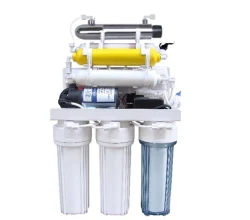Here are the key components and features of UV water filters
2023-12-18
UV filters, in the context of water treatment, refer to ultraviolet (UV) disinfection systems designed to eliminate or inactivate microorganisms, such as bacteria, viruses, and protozoa, in water. UV water filters use ultraviolet light to disrupt the DNA of these microorganisms, preventing them from reproducing and rendering them harmless. Here are the key components and features of UV water filters:
1. UV Lamp:
- Type: Low-pressure mercury vapor lamps are commonly used.
- Wavelength: UV-C light in the range of 254 nanometers is most effective for disinfection.
- Function: Emits UV light to target and disrupt the DNA of microorganisms, preventing them from reproducing.
2. UV Chamber or Reactor:
- Material: Typically made of stainless steel or another UV-transmitting material.
- Function: Surrounds the UV lamp and ensures that water passing through is exposed to the UV light for effective disinfection.
3. Quartz Sleeve:
- Material: Made of high-purity quartz.
- Function: Surrounds the UV lamp and separates it from the water to protect the lamp while allowing UV light to penetrate into the water.
4. UV Intensity Sensor:
- Function: Monitors the intensity of the UV light to ensure that it remains at a level effective for disinfection. Some systems automatically shut down or provide warnings if the UV intensity falls below a certain threshold.
5. Flow Control System:
- Function: Regulates the flow rate of water through the UV chamber to ensure that sufficient contact time is provided for effective disinfection.
6. Electronic Ballast:
- Function: Powers the UV lamp, maintaining a consistent and stable output of UV light.
7. Indicator Lights and Alarms:
- Function: Provide visual or audible signals to indicate the status of the UV system, including when the lamp needs replacement or if there is a malfunction.
8. Pre-Filtration:
- Type: Sediment filters or other pre-filtration may be used to remove larger particles and improve the effectiveness of UV disinfection.
How UV Water Filters Work:
- Exposure to UV Light: As water flows through the UV chamber, microorganisms are exposed to the UV light emitted by the lamp.
- DNA Disruption: The UV light penetrates the microorganisms and disrupts their DNA, preventing them from reproducing.
- Inactivation: While the microorganisms may not be immediately killed, their ability to reproduce is compromised, rendering them harmless.
Applications of UV Water Filters:
- Residential Drinking Water: UV filters are commonly used in point-of-use or point-of-entry systems to disinfect drinking water.
- Wastewater Treatment: UV disinfection is employed in wastewater treatment plants to inactivate pathogens before discharge.
- Aquariums: UV filters help maintain water quality by eliminating harmful microorganisms in aquariums.
- Commercial and Industrial Settings: UV disinfection is utilized in various industries, including food and beverage, pharmaceuticals, and healthcare, to ensure water quality.
Considerations:
- Water Quality: UV disinfection is most effective in clear water. Pre-filtration may be necessary to remove particulate matter that can reduce UV effectiveness.
- Maintenance: Regular maintenance, including replacing UV lamps and cleaning quartz sleeves, is essential for optimal performance.
- Effect on Chemical Contaminants: UV filters are primarily designed for microbial disinfection and may not remove chemical contaminants. Additional filtration stages may be required for comprehensive water treatment.
UV water filters are a popular and effective method for disinfecting water without the use of chemicals. They provide an additional layer of protection in water treatment systems, especially in situations where microbial contamination is a concern.



